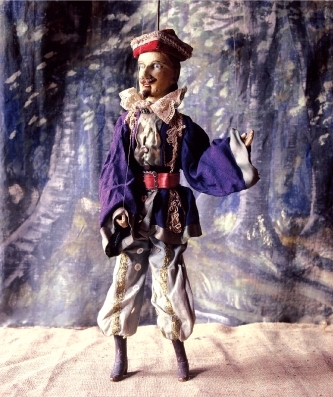Juraj Hamar
Several dozens of puppet families remained to do their puppet shows after the WWII and travelled around Slovakia, Moravia, Carpathian Ruthenia or Silesia. The Communist regime almost eliminated the traditional puppet theatres during the 1950s. Traditional puppets and makers and artisans (designers, carvers and painters) who used to create them, they all vanished.
Being a member of third generation, Anton Anderle of Banská Bystrica preserved the puppet show tradition of Anderle family from the village of Radvaň. They were among the families that were banned by then regime to do puppet shows in 1955. However, the family withstood the ideological pressure. Like his father Bohuslav and uncle Jaroslav, Anton Anderle started to learn about the trade in early childhood. He assisted in manipulating father´s puppets, helped to change costumes after the end of a show, built decorations, prepared acoustic effects and did other minor tasks.
Anton decided to return to puppets when he had seen his father´s performance in Martin in 1970, which he had been allowed to make after fifteen years. After the 1989 events, he officially revived the family tradition. By the end of the 20th century, “The Anton Anderle Traditional Puppet Theatre” gained reputation of being among the most popular folk puppet theatres in Europe.
Marionettes – the puppets suspended and controlled by a number of rods and strings – were the most popular variety of puppets that folk puppeteers in Slovakia and Czech Republic used until the mid 20th century. The control rod was secured to the head or was going through the head to the centre of puppet’s body (allowing heads to be replaced, if necessary). Strings were going through the inside of the trunk (which was usually empty from the rear side) and were attached to the balance lever. The clown Gašparko, controlled by strings, was the only puppet with no rod in its head. Being introduced into our traditional theatre later, trick puppets were manipulated very similarly.
Expressions on their faces and design of their clothes were important for the system of symbols used in the folk theatre. Both aspects helped audience in decoding their personal characters. Puppeteers were poor people and often owned only one set of puppets (around 12 – 18 pieces). They changed their costumes to let them play various characters.
Every other folk puppeteer made puppets himself. When they did not have money to buy whole figures, they purchased heads and lower parts of legs and arms and made the rest of the body. This combined approach makes it difficult to identify who exactly was the creator of a puppet. Several puppets were so famous that competing makers made their replicas which also complicate the identification of the origin of such puppets.
Many puppet carvers were active in the town of Rajec. The region around Banská Štiavnica (Hodruša, Piargy, Štiavnické Bane) with a carving school has a history in puppet making, too. However, dozens folk puppet makers were active around the whole of Slovakia until the second half of the 20th century.
Anderle has built his collection from the puppets that remained in the family. Other puppets have come as gifts, purchases from other famous puppet families and exchanges with other collectors. The collection contains puppets from folk makers as well as puppets from the leading makers in the Czech Republic and Slovakia. In addition to the puppets of Slovak and Czech origin, Anderle has acquired puppets from other nations and cultures in Europe, Africa, Asia and South America. Anderle collected around one thousand puppets during 35 years of his collecting passion. The collection also includes numerous theatre decorations, curtains, props, old posters and other printed materials, texts, manuscripts, photographs, books and sound and audiovisual records.
Anton Anderle passed away suddenly on 16 May 2008, at the top of his puppet show career, after he gained international reputation and when he was close to the fulfilment of his lifelong dream of establishing a puppet museum from his puppet collection, library and archive…
